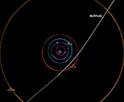When to See Meteor Showers: A Calendar of Night Sky Events and Clasification
Meteor Showers: Classification and When to See the Phenomenon
Reading time : 1 minute,
Discovery Chepe Id-772-TEC
Published in
06-26-2025

Photo: Madhuvan Yadav
Meteor showers are one of the most beautiful astronomical phenomena that anyone can enjoy without a telescope. Every year, stargazers around the world turn their eyes to the sky to witness these sudden flashes of light that trace across the darkness like fleeting wishes.
Definition: A meteor shower occurs when the Earth passes through a stream of debris left behind by a comet or asteroid. As these particles enter the Earth's atmosphere at high speed, they burn up and create glowing trails, commonly known as shooting stars.
Classification:
To better understand meteor showers, scientists have grouped them into several categories:
a) By origin: Most showers come from comets, which shed ice and dust as they approach the Sun. Others come from asteroids that have broken apart over time.
b) By radiant: The radiant is the point in the sky from which the meteors appear to originate. The name of the shower usually refers to this constellation. For example, the Perseids appear to come from the constellation Perseus.
c) By frequency: Annual showers like the Perseids and Geminids are predictable and occur every year. Irregular showers, like the June Bootids, may vary significantly in activity.
d) By intensity: Some showers produce a few meteors per hour, while others, like the Quadrantids or Geminids, can produce over 100 meteors per hour during their peak.
When to watch:
Meteor showers happen throughout the year, but each has its own peak nights and viewing conditions. Here are some of the most notable ones:
1- Quadrantids: Peak in early January. High rate but short window of activity.
2- Lyrids: Mid-April. A modest shower known for occasional bright meteors.
3- Perseids: Mid-August. One of the most reliable and best-loved showers, ideal for summer viewing.
4- Geminids: Mid-December. Offers bright, colorful meteors and is visible all night long.
To check upcoming meteor showers and their visibility in your region, sites like Time and Date or EarthSky offer detailed guides and calendars.

Meteor Showers: Your Complete Guide to Celestial Spectacles
Photo: Ryan Photos
Tips for observing:
1- Choose a location far from city lights.
2- Allow your eyes 20-30 minutes to adjust to the dark.
3- Avoid looking at your phone, as white light ruins night vision.
4- Lie on your back and look toward the darkest part of the sky.
A human connection to the cosmos
There is something deeply emotional about watching a meteor shower. It reminds us of how small we are in the vastness of space, yet how connected we are to the universe. In many cultures, a shooting star is a sign of hope, a moment to make a wish, or even a message from the divine.
For scientists, meteor showers are also a chance to study the solar system's history. These tiny particles are remnants of ancient comets, drifting in space for thousands of years before finally meeting Earth.
Whether you're a seasoned astronomer or just someone who enjoys lying on a blanket under the stars, meteor showers offer a moment of wonder and reflection. Mark your calendar, head outside, and look up. The universe has something to show you.
Written with curiosity and stardust
See Also
Discovery Chepe
Most read...














